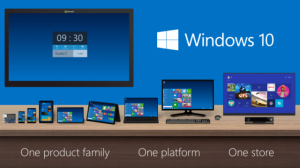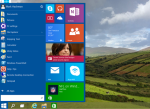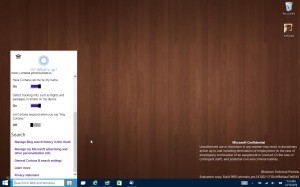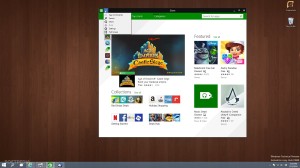 Have you seen the new Windows 10 screenshots? It sure is looking like Microsoft has listened well to the voluminous criticisms of Windows past—ahem, Windows 8.x.
Have you seen the new Windows 10 screenshots? It sure is looking like Microsoft has listened well to the voluminous criticisms of Windows past—ahem, Windows 8.x.
After Windows 8 came out, I posted on this blog what I thought about the new look/interface. Later, I posted another apologist piece seeking to rebut negative criticism where warranted. Now with a peek behind the scenes of development for the new version, we can make a limited assessment of how they’re handling previous issues moving forward.
“Metro” Interface/Start Menus and Screens
First and foremost, while I liked—and continue to like—the new Start Screen (not speaking of the Start Menu), I do understand that it was such a major paradigm shift it became a huge distraction and radical turn-off. And for those without touch screens, for which it was optimized, it presented a paradigm shift that appeared wholly unnecessary. For many, that was very much true.
 But Microsoft seems to have realized their folly, and so have brought back the Start Menu—though not without remarkably constructive modifications. The changes going forward are nothing like the acquiescing minor revisions of Windows 8.1. Now the Start Menu actually shows Live Tiles, and can expand to show more (or contract to less) if you want—the best of both worlds. And of course just like on your Windows Phone, you’ll be able to size the tiles to your own needs/preferences.
But Microsoft seems to have realized their folly, and so have brought back the Start Menu—though not without remarkably constructive modifications. The changes going forward are nothing like the acquiescing minor revisions of Windows 8.1. Now the Start Menu actually shows Live Tiles, and can expand to show more (or contract to less) if you want—the best of both worlds. And of course just like on your Windows Phone, you’ll be able to size the tiles to your own needs/preferences.
As an aside, you can still choose to boot up into the Start Screen, though the default for desktops and laptops will be the Start Menu. This is a real advantage for tablet users and a nod to the idea that the “Metro” interface will survive into the future.
Charms Bar/Search
One of things I love about Windows 8 is the Search function on the Charms Bar. Even though it was sometimes irritating to have to swipe/pull down from the corner to get to, it was so much more pleasant to be able to search so quickly—as apposed to loading a browser, then a search engine website, then typing in the search. It felt more fluid with the Charms Search feature. I got hooked, and then couldn’t understand why my wife never remembered about it (though she’s since seen it’s value)!
 Well Microsoft has now added the option of showing a search box directly on the taskbar—you can now search directly from the desktop without having to swipe at all. And of course, you can still search in just one app; locally just on the PC; across the entire web, or anywhere in between; not to mention searching just for images or just for videos. And I much prefer Bing where, according to Microsoft, they don’t constantly mine your data like some other search engines.
Well Microsoft has now added the option of showing a search box directly on the taskbar—you can now search directly from the desktop without having to swipe at all. And of course, you can still search in just one app; locally just on the PC; across the entire web, or anywhere in between; not to mention searching just for images or just for videos. And I much prefer Bing where, according to Microsoft, they don’t constantly mine your data like some other search engines.
Add to all this the brilliant Cortana, who’s being asked to integrate into the search functions as well (I’m sure she’ll be happy to oblige). After my iPhone experience, I can tell you she’s an order of magnitude more helpful and productive than the glorified search assistant Siri. Searching as part of productivity will never be the same.
Window Behavior
OK. The Charms Bar is still there (except for the Settings charm). But they’ve now also incorporated the charms into every window’s top-left “control” menu. And what’s more… One of my beefs with Metro was that I didn’t necessarily want to have a particular app be full-screen—actual windows suit me just fine. And I found the snap functionality of having two full-screen apps side-by-side to be worthless.
 Well, they’ve now managed to set up Metro apps to work either way; either full-screen as we’re used to, or in windows that hover over the desktop. A perfect balance of form and functionality…
Well, they’ve now managed to set up Metro apps to work either way; either full-screen as we’re used to, or in windows that hover over the desktop. A perfect balance of form and functionality…
As for the new windows themselves, they’ve added some level of shadowing for a pretty nice 3D experience—windows actually look like they’re suspended in space while in front or behind one another. I find it to represent the future, whether elegant or not. At least they’re not so flat. like in Windows 8.
And they’re adding a new feature allowing you to create multiple desktops. Apparently you can now have your icons and eat them too. I’m wondering if this will be a boon to those (like me) who work with multiple monitors.
Live Tiles
I’m actually a big fan of live tiles—whether on my PC, my tablet, or my phone. This is hands down the greatest thing to happen to computer devices since windows were added to DOS (or OS/2—do you remember the “original” Windows, developed by Microsoft together with IBM?)!
For the past several months I’ve been working daily with an iPhone 6 because of my work (time for another blog post 😉 ). I’m sorry, but after playing with this device I’ve realized that I’ve left behind the days of icon-centric computing. It’s so 1990s…
To further an analogy I used previously, Live Tiles are like having a bookshelf full of books that show the current page inside them on their spines—and you get to choose how big you want the spine to be to show how much of the page you want to see.
Seriously, how can any of us go back to the plodding world of opening an app to find the information inside it after having exposure to that kind information system? Sorry Android and iPeople…
~ ~ ~ ~ ~ ~ ~ ~
This will be the first major release of the operating system under the new CEO, Satya Nadella. While these represent just a few aspects of the new Windows 10 being shown—and experienced—by others, we’ll get a better idea come sometime this month. We’ll also begin to sense the trickle-down of Nadella’s leadership and vision.
Until then…


